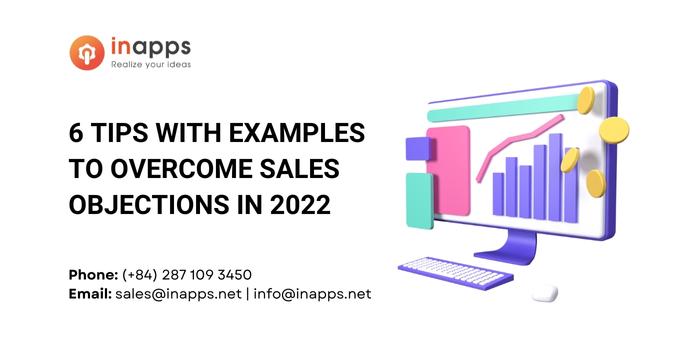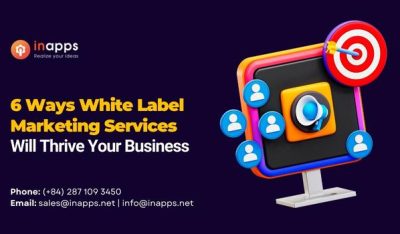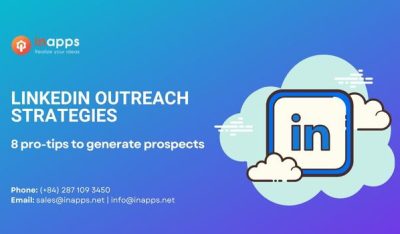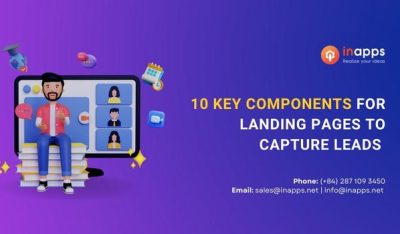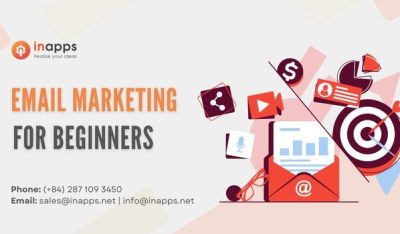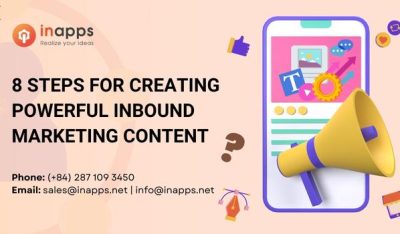- Home
- >
- Inbound Marketing
- >
- 6 Tips with examples to overcome Sales Objections in 2022
6 Tips to Overcome Sales Objections in 2022 (With Examples) is an article sent to you by the InApps editorial team. Hope readers will have more useful knowledge at www.inapps.net
Nothing is worse than putting in the time and effort to guide a stellar lead through each step of your sales process… all for that person to put a wall up at the last second and ghost you. What went wrong? If this has happened to you (and we know it probably has – more than once), then you are probably here to find out how to overcome sales objections from your prospects.
Here’s the thing. You’re not the only business that has experienced the sting of a sales objection. Nearly every industry and every company, big and small, will come face-to-face with a lead’s unwillingness to move forward with the sale. It’s just part of the game.
Luckily, there is a way to combat sales objections and still land the lead in the end. In this article, you will learn:
- What sales objections are
- Reasons why a lead would object
- 6 sales objection examples
- Best rebuttals to win back the sale
Ready to get started? Follow these tips to learn how to overcome sales objections in 2022.
What Is a Sales Objection?
In simple terms, a sales objection is a type of barrier – such as a concern about a product or service – that a lead puts up before an actual sale occurs. Oftentimes, the lead needs more answers before they are willing to go further down the sales funnel.
In other words, a sales objection is a “NO” to your request to do business with them… at least until all of their doubts, fears, and concerns about your brand have been eased first.
Sometimes, this hesitancy can cause great leads to drop off of your radar and turn cold. If only you could have answered their questions and eased their minds, these leads could have easily turned into paying customers!
So, what caused them to dig their heels into the dirt and object? Let’s jump right in!
Common Reasons for a Sales Objection
The answer to that question is tricky. It all depends on your lead’s wants, needs, and desires at the time of their objection.
This means that their “NO” could have come from a variety of reasons.
For instance, some of the most common reasons for buyer hesitancy include:
- Lack of trust (in the product, service, and/or brand)
- Lack of knowledge (about the product, service, and/or brand)
- Takes too much time to close the sale
- Too expensive
- Not ready to commit
- Risk outweighs the reward
- Difficulty to act (don’t know how to purchase the product or service)
Here’s the good news. If you are able to deduce the reason for their objection right up front, you will have an easier time resolving it. This leads us to our next point…
Can a Business Avoid Sales Objections?
Here’s something we can all agree on: Relationships can make or break business deals. Why do you think so many business big-wigs put such an emphasis on networking?
Well, the same goes for you and your leads. A simple relationship can go A LONG way. In fact, what if we told you that strong relationships could actually save you from the headache of sales objections?
Although you might not be able to completely AVOID sales objections, you can at least soften the blow.
How Relationship-Building Eases Sales Objections
If you are able to build a bond with your prospects from the very beginning, you are less likely to experience buyer hang-ups along the way. But, when barriers do come up, you will have an easier time helping them overcome any objections they may have.
This is because there is a better chance that your prospective buyers will TRUST you enough to stick with your brand instead of being completely deterred… all thanks to the relationship you built with them from the beginning!
How To Overcome Sales Objections: Start With the 3-Step Plan
So, now that you know that sales objections are often unavoidable, it’s time to address the elephant in the room…
How on earth do you rebuttal sales objections and still secure the lead?!
Well, although there might not be a one-size-fits-all approach to overcoming sales objections, we do have a simple plan you can follow to triumph over sales objections.
It’s as simple as 1, 2, 3.
- Find the root of the problem: What is your lead’s true pain point(s)?
- Take an empathetic approach: Can you put yourself in your lead’s shoes? Try to understand why they are feeling hesitant.
- Understand the entire situation: What type of situation is your lead in that is causing them to put up a wall? Is it a situation that you can help them with?
You’ll be surprised how well people respond to empathy. It helps you to find common group with the person you are trying to sell to.

Once you understand your potential lead’s issue and why it is preventing them from buying, it becomes much easier to sell to them.
With these 3 simple steps, you can easily identify and alleviate many sales objections that come your way. Now, let’s take a look at some examples.
6 Sales Objection Examples and How to Resolve Them
In this next section, we will go through 6 of the most common sales objection examples. First, we will identify the problem, and then we will show you how to resolve it.
Remember to keep the 3-step plan in your head as you read each of these examples. Ready for the first one?
1. The “Over My Budget”
Think of a time when you wanted to buy a revolutionary new product.
You were so excited about it when you first saw the item advertised online, on tv, or used by a friend. However, after doing more research, you realized that the product is pricey.
Pretty quickly, you knew you would have to make a pretty big investment to obtain this item. You started asking yourself, “Is it really worth it? Could I use the money to buy something better? Do I want to spend this kind of money right now?”
This type of sales objection is super common in the business world, especially for products and services that cost a pretty penny. So, how do you overcome the “over my budget” mentality?
Here’s the Solution
Well, to resolve this situation right off the bat, you need to:
- Understand your client’s pain points: Empathize with their problems. Remember our 3-step plan?
- Agitate those pain points: Paint a picture of what the client is experiencing and why they should NOT have to go through this pain!
- Position your product/service as the ultimate solution to those pain points: Show them how your brand will alleviate all of the pain and why it’s worth the steep price tag.
In other words, it’s a good old-fashioned “risk vs reward.”

The more risk you take, the higher the potential for reward.
You need your product or service to be the BEST answer to your client’s problems, so they are more willing to spend the money on it rather than freeze and drift away.
And if they don’t sign up for your brand, then they will continue to experience their pain points… and no one wants that!
2. The “I Don’t Have a Use for This”
Another sales objection you might face is the person who doesn’t ‘need’ your product or service. A lack of need demonstrates 2 key aspects.
First, the person might not be the right fit for your company. In other words, they are not a strong lead. Second, the person doesn’t know WHY they need your product or service.
Here’s the Solution
In the case that a prospect doesn’t know why they need your brand, then it is a great opportunity for you to give them more information about what you do and how your brand will help them.
During this process, be sure to ask open-ended questions to guide the conversation. This will help you uncover pathways that can lead to a pain point they might have.
Then, connect the dots between their problem and the solution. Show them how your product or service will resolve that pain point.
And just like that, you took the lead from “I don’t need this” to “Okay, maybe I do actually need this! How do I sign up?”
3. The “Can I Trust You?”
We’ve all been there. We want to take the plunge with a company, but something is holding us back…
Trust.
A lot of times, lack of trust can be one of the biggest roadblocks for a business. Clients are more than willing to spend the money on your products, services, and ideas, but they just aren’t sure if your brand is going to deliver.
If you want to know how to overcome sales objections like this common one, keep reading.
Here’s the Solution
It’s no secret that people prefer to conduct business with people they know and trust. This is where relationship-building really helps you out.
If you have the opportunity to foster a relationship with your lead first, then they are more willing to trust your word about your product or service.
First, you can create a lead generator, such as an epic email sequence, to nurture your leads and build trust with them.
Next, always find new ways to promote trust and credibility in your industry. For instance, showcase positive reviews, develop video testimonials, advocate for your company through influencers, and write blogs that reach the needs of your leads.
This will amp up the trust factor for your prospects!
4. The “I Don’t Have Time for This Right Now”
Are your leads brushing you off? Maybe you have even been ghosted on a few occasions. If so, this is commonly caused by a sales objection known as a lack of urgency.
When it comes to a lack of urgency to act, you can assume that your business isn’t doing a good enough job of agitating the client’s pain points and calling them to action.
Remember the whole risk vs reward concept we mentioned earlier? This revolves around the same concept.
Here’s the Solution
First, you need to paint a picture of urgency. Why does your lead need you and why do they need you NOW? Then, finish with a killer call to action (CTA).
For example, if you’re trying to sell an electric vehicle to someone who already has a gas car and you don’t agitate any of their pain points, why would they buy the electric vehicle? After all, they already have a car!
However, if you know your prospective client is having a hard time paying for gas and is worried about their future, then you can easily pick at that pain point. Position your product as the solution and urge them to switch to an electric vehicle before gas prices rise even higher!
5. The “I Don’t Know How To Proceed”
Sometimes, sales objections are presented as “I’m confused” or “This process is too difficult.” Oftentimes, this spawns from a lack of direction on what to do next.
Therefore, if your product, service, and/or sales platform is too complicated or confusing, your leads will probably just click off or say they are not interested.
So, want to know how to overcome sales objections like this one? It’s easier than you might think!
Here’s the Solution
Give your lead a PLAN. This is particularly important to do if you receive a lot of objections online.
Did you know that the average online user stays on a web page for a mere 10-20 seconds? That’s not a whole lot of time for you to leave a positive impression on your leads.
With that being said, it’s more important than ever to use clear, concise, and easy-to-read language on your website.
You also need to give your target audience an easy plan to follow so they know how to proceed.
How To Make a Plan
More often than not, a plan also doubles as a CTA. The plan is meant to break down the steps of your sales process to make it way less intimidating for the lead. It also encourages them to go ahead and make the purchase.
For instance, a medical facility might put this plan on their website:
- Schedule a Free Consultation
- Talk to a Weight-Loss Specialist
- See Real Results within 2 Weeks!
Or, a meal service company might say this:
- Click “Get Started”
- Choose Your Favorite Dishes
- Get Fresh Meals Sent Straight to Your Door
Here’s how you might see a plan laid out on a website.

See, it’s as easy as that!
When someone sees their exact path laid out for them, they’re much more likely to move forward.
6. The “I’m Already Signed-Up With Your Competitor”
Ouch! This one might sting a little. However, if you run into this type of sales objection, don’t give up just yet!
In fact, there is still plenty of wiggle room to build a relationship with this kind of lead. For starters, there is great news: They are the right lead for your industry because they already use a similar product or service!
Here’s the problem: They are using a different vendor as a solution to their pain point.
So, if you are wondering how to overcome sales objections like these, keep reading.
Here’s the Solution
Just because a lead is already signed up with a competitor doesn’t mean their needs are being met. Perhaps you can still offer them something that WILL resolve their problem. Maybe YOUR business will provide more relief to their pain.
Instead of just leaving the lead cold, ask them the following questions:
- How is your relationship with xyz?
- What’s working well?
- What’s not working well?
- Have you seen improvements/reached your goals since working with them?
Then, finish strong by stating “Let me explain how our product, service, or brand is different.”
Even if the lead doesn’t sign up for your product or service right away, it’s still a great way to keep your foot in the door.
If anything happens to their current relationship, there is a good chance they will remember you and come back to you.
How To Overcome Sales Objections With Ease
In this article, you learned how to conquer some of the most common types of sales objections out there.
Remember, sales objections are often unavoidable. Everyone experiences them.
However, if you prepare properly, you can come back with a great rebuttal and continue to build a relationship with your leads.
Want more marketing insights that will help you seal the deal? Learn how to create a stellar landing page that converts more leads. Or reach out to one of our digital marketing strategists to see how a customized digital marketing approach can skyrocket your sales.
Follow this to make sure you’ve got 6 Tips to Overcome Sales Objections in 2022 (With Examples). Save and share with those around you these extras.
To learn more about Inbound Marketing
Contact us:
www.inapps.net
Let’s create the next big thing together!
Coming together is a beginning. Keeping together is progress. Working together is success.




